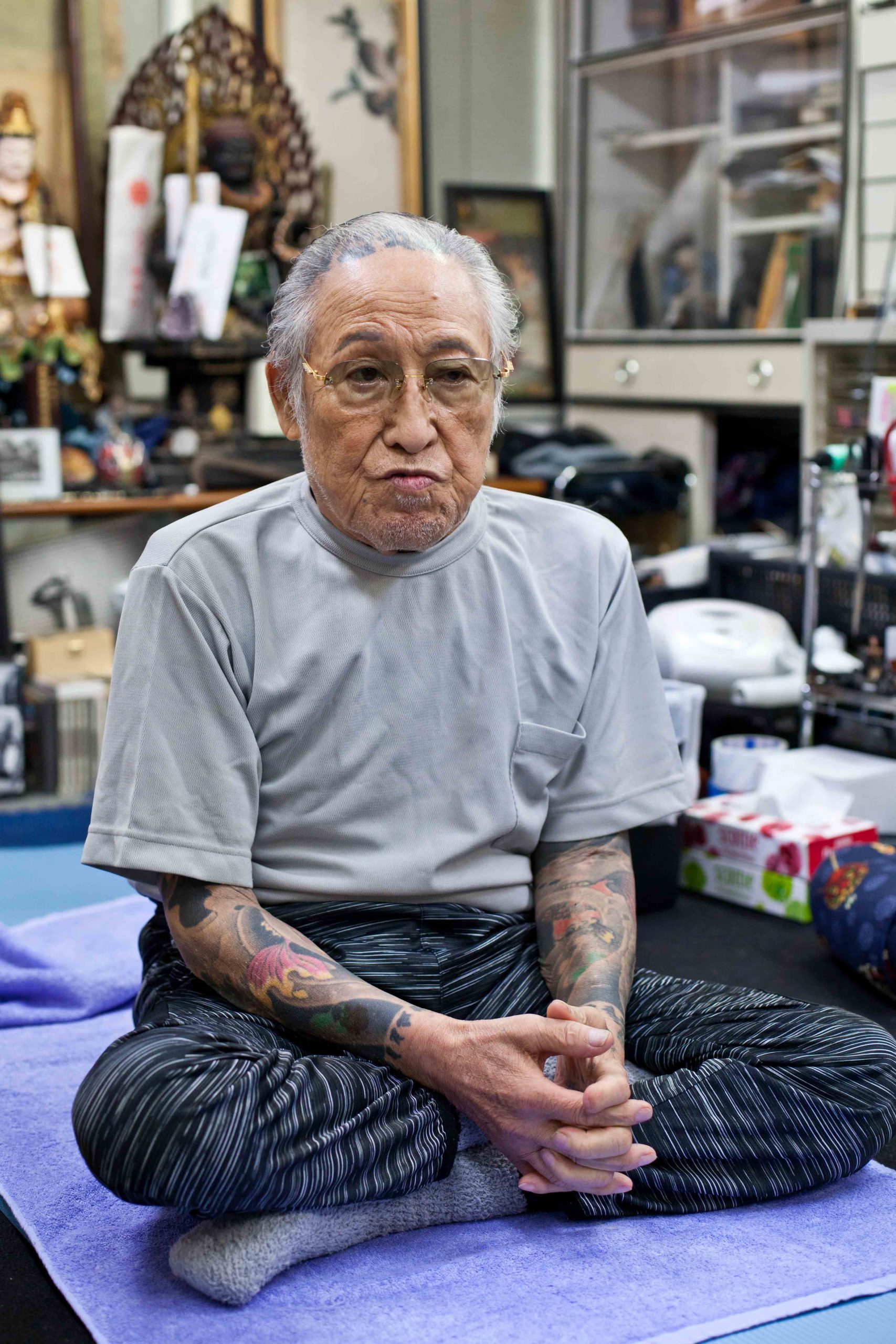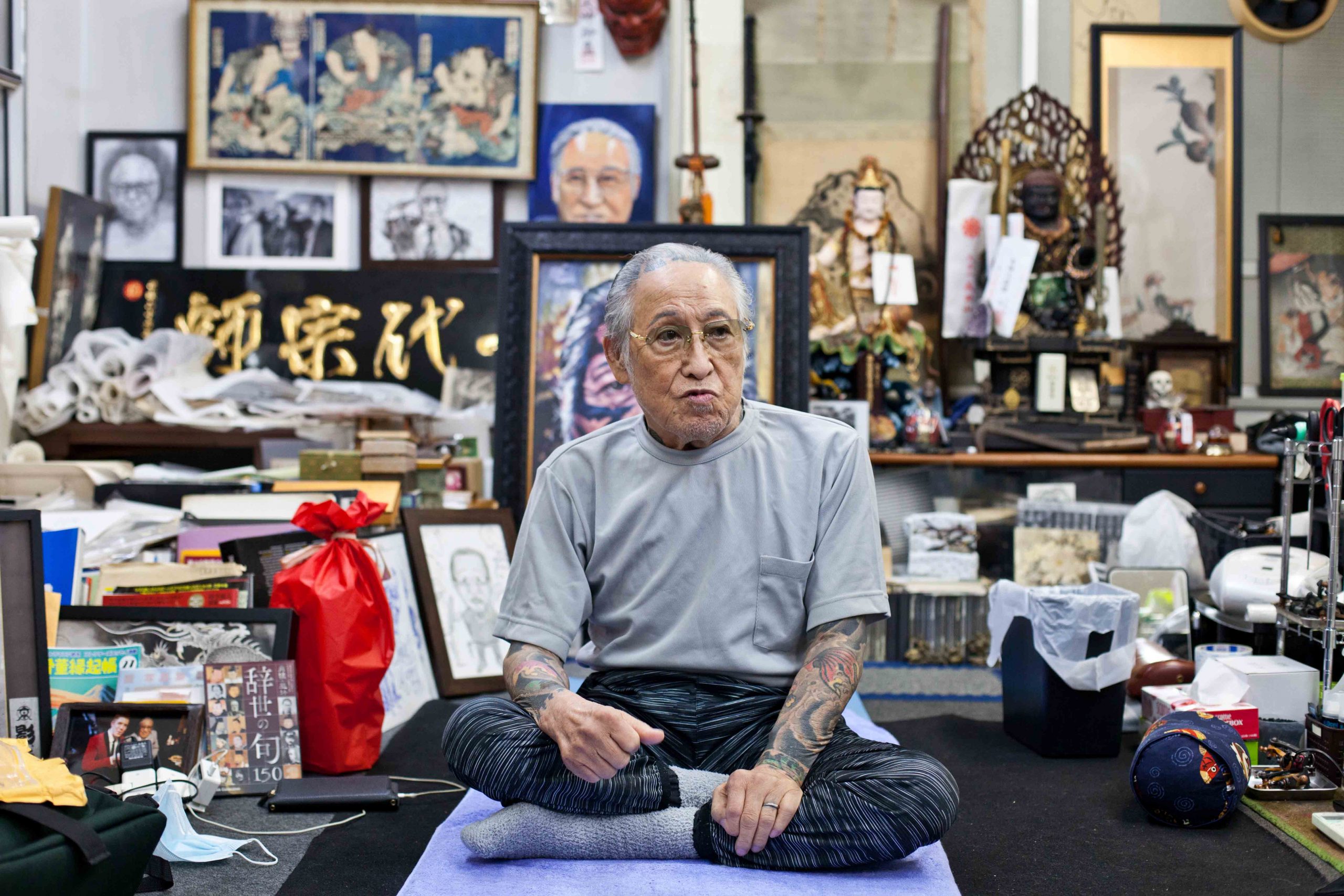After the book’s publication in 2022, I was eager to get the impressions of Japanese tattoo artist Horiyoshi III. During the conception of the book, the Yokohama legend had done me the honour of helping me to identify the tattoo artists and the themes of the tattoos photographed by Takagi. The reopening of Japan’s borders in 2023, after years of closure due to the Covid 19 pandemic, meant that our reunion could finally be scheduled. Here is a transcript of our interview, conducted in June at Horiyoshi III’s studio in Yokohama.
Translation: Fujikawa Makoto / Photos : P.Bagot
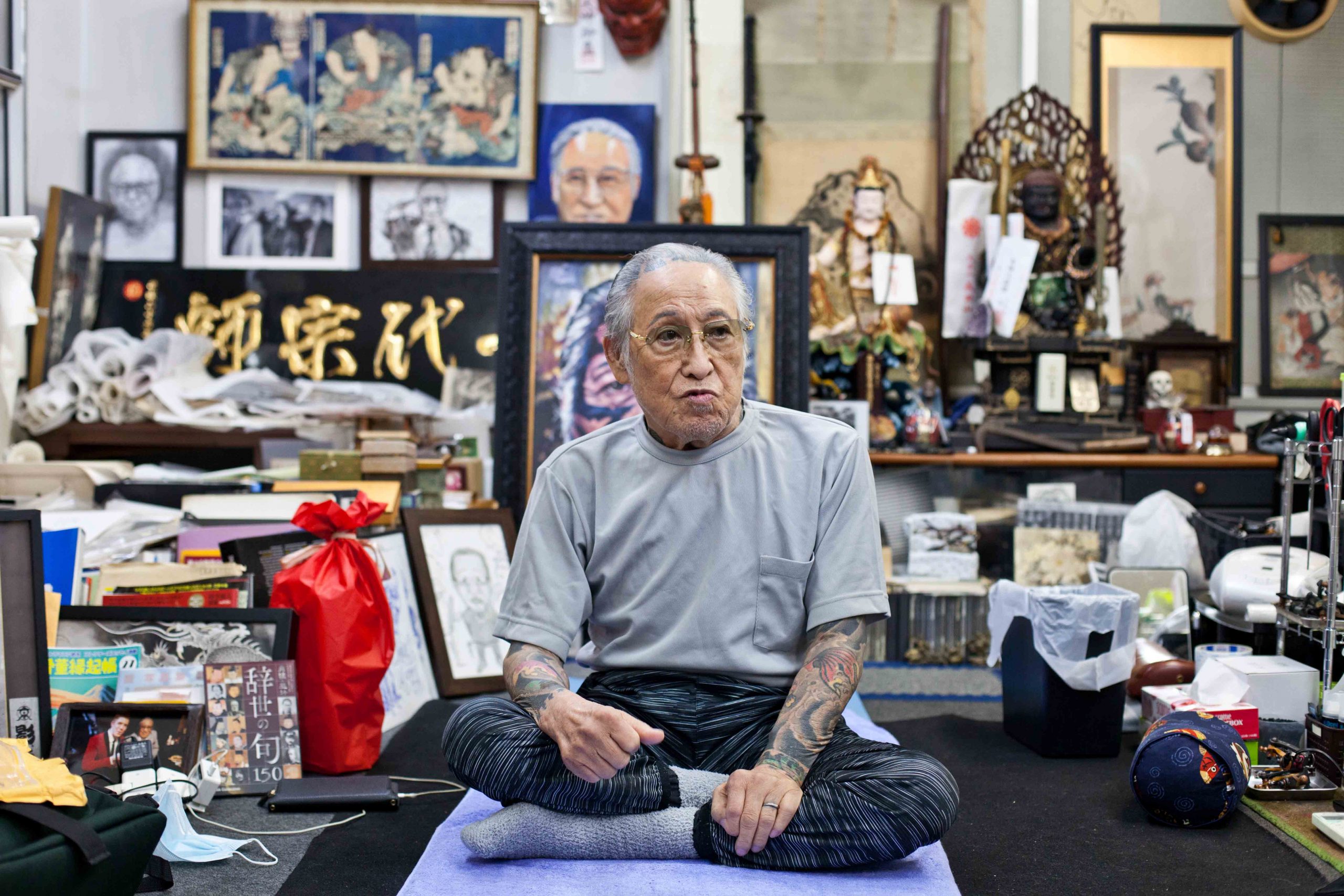
Hello Sensei, what did you think of the book?
All I can say is that it’s magnificent. I think it’s great to have so many photos in one book. It’s very stimulating. For me, but also for young tattoo artists. But that doesn’t mean it will be useful for them. Japanese tattooing is gradually evolving by mixing with Western styles, and very few tattoo artists today are pursuing tattooing as the great masters Horiyoshi I, Horigorō I, Horiuno II did. What they produce is a more or less degraded copy of their style.
Did you know Mr. Takagi before you saw his photographs?
Yes, for a long time. I used to have a tattoo enthusiasts’ club, the Yokohama Chōyūkai, and Mr. Takagi came to one of its end-of-year meetings with his wife. We chatted a bit, took a photo together and looked at some tattoo images before they headed off to another meeting. Mr. Takagi was already at the end of his life when I met him.
So it was a real surprise to learn that he was a photographer?
Yes, even though I knew he had photographs. While writing his first novel, Mr. Takagi interviewed Horiuno II and got to know other tattoo artists connected with the Edo Chōyūkai club. As a result of this meeting, he got to know Horiyoshi II, Horigorō II and other unknown tattoo artists. For me, there’s a kind of triangulation, between Mr.Takagi, the tattoo community and his novel.
How did you feel when you saw his images?
Not all the tattoos you see are good, but some are very impressive. Several times I felt a sense of strength. Contemporary tattoo artists wouldn’t be able to reproduce such works without creating something more beautiful, something finer. That’s not to say that you have to draw in a crude way, but it has to be somewhere in between. Today, for example, we use three levels of ink gradation – usuzumi, chuzumi and honbokashi – but in the past, there was only dark or light. The akebono bokashi technique (gradient technique, from the lightest to the darkest) did not exist. These tattoos had more strength and impact. They had an aji.
Can you explain what is meant by the idea of aji, in other words taste?
It’s a difficult question! When we say that a sword is very good, that it has good aji, it’s not a question of beauty. It doesn’t matter whether it’s fine or coarse, it has more to do with the totality of the work. My master Horiyoshi I often said that you shouldn’t worry about technique when you look at a drawing. It doesn’t matter whether it’s clumsy or not, and whether or not the artist is a draughtsman, you have to observe it carefully enough to see whether or not it has taste.
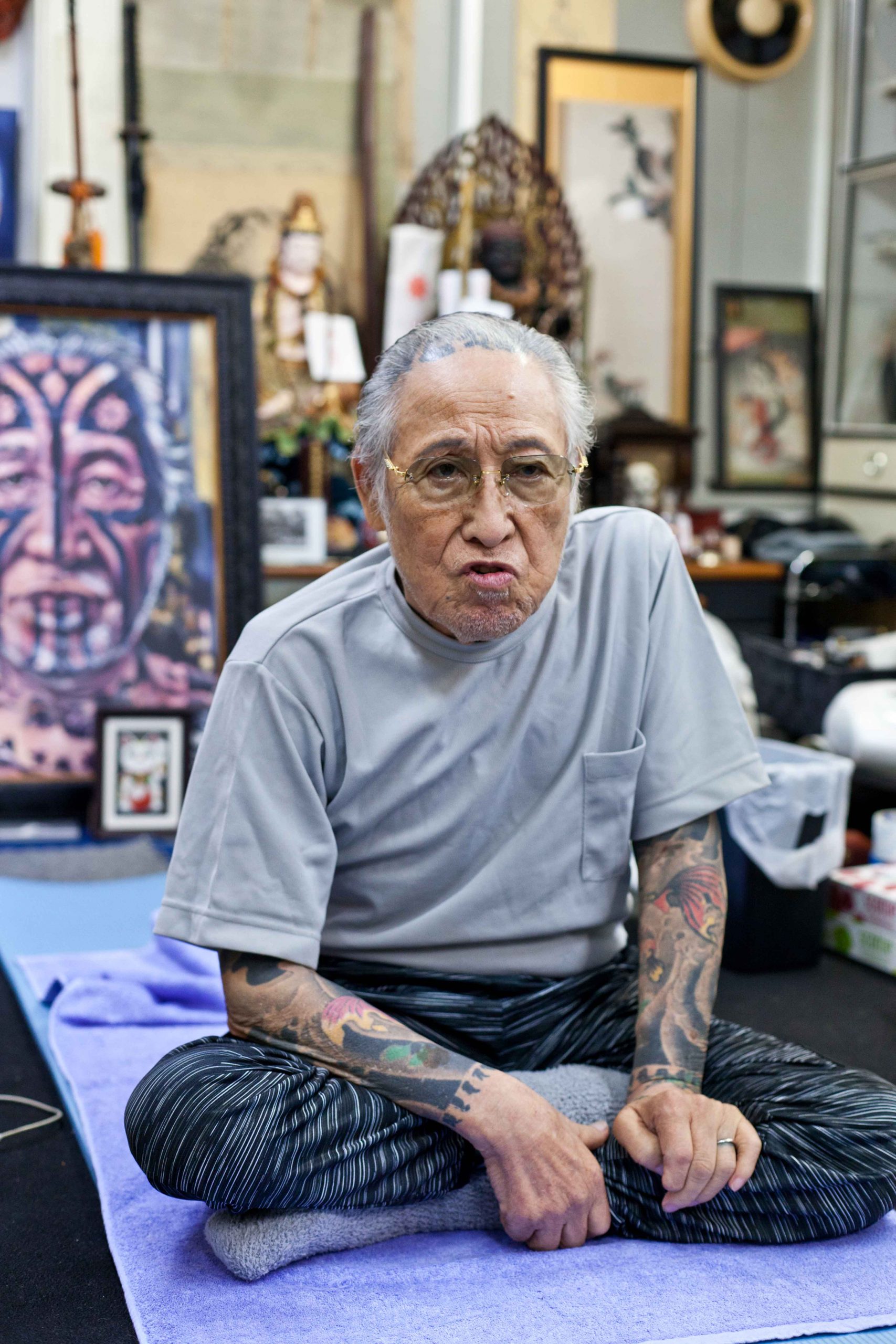
Mr Takagi liked tattooed women and probably found them fascinating. Do you understand this feeling?
Yes, I can understand why tattooed women might seem more sensual to some people. As far as I’m concerned, it depends on the woman. An ugly woman won’t seem more sensual to me if she has a big tattoo. My friend, the late painter Ozuma Kaname, knew all about this relationship between tattooed women and sensuality. But, in the end, I don’t think there are many men who find tattooed women more attractive.
Do you yourself like tattoos on women?
Not so much to be honest. I’m rather against body-suits for women, and munewari too. And I don’t really like tattooing women. The work is more difficult when, for example, they want to hide their breasts. Most of my clients are men.
In the history of Japanese tattooing, one tattooed woman is particularly well known: Hagoromo Osayo, a client of tattooer Horiuno II.
No other tattooed woman was as famous as Osayo. She was already very beautiful, which is rare enough to explain why Horiuno II put so much effort into her tattoo. Perhaps to make her even more beautiful, although a professional doesn’t usually distinguish between clients. He does the best he can, regardless of the beauty of each individual. But with Osayo, it was probably different. There was something special about her, you can imagine that there was a special bond between the tattooer and her. It’s one of the tattooer’s greatest works. From a purely aesthetic point of view, it had extraordinary value.
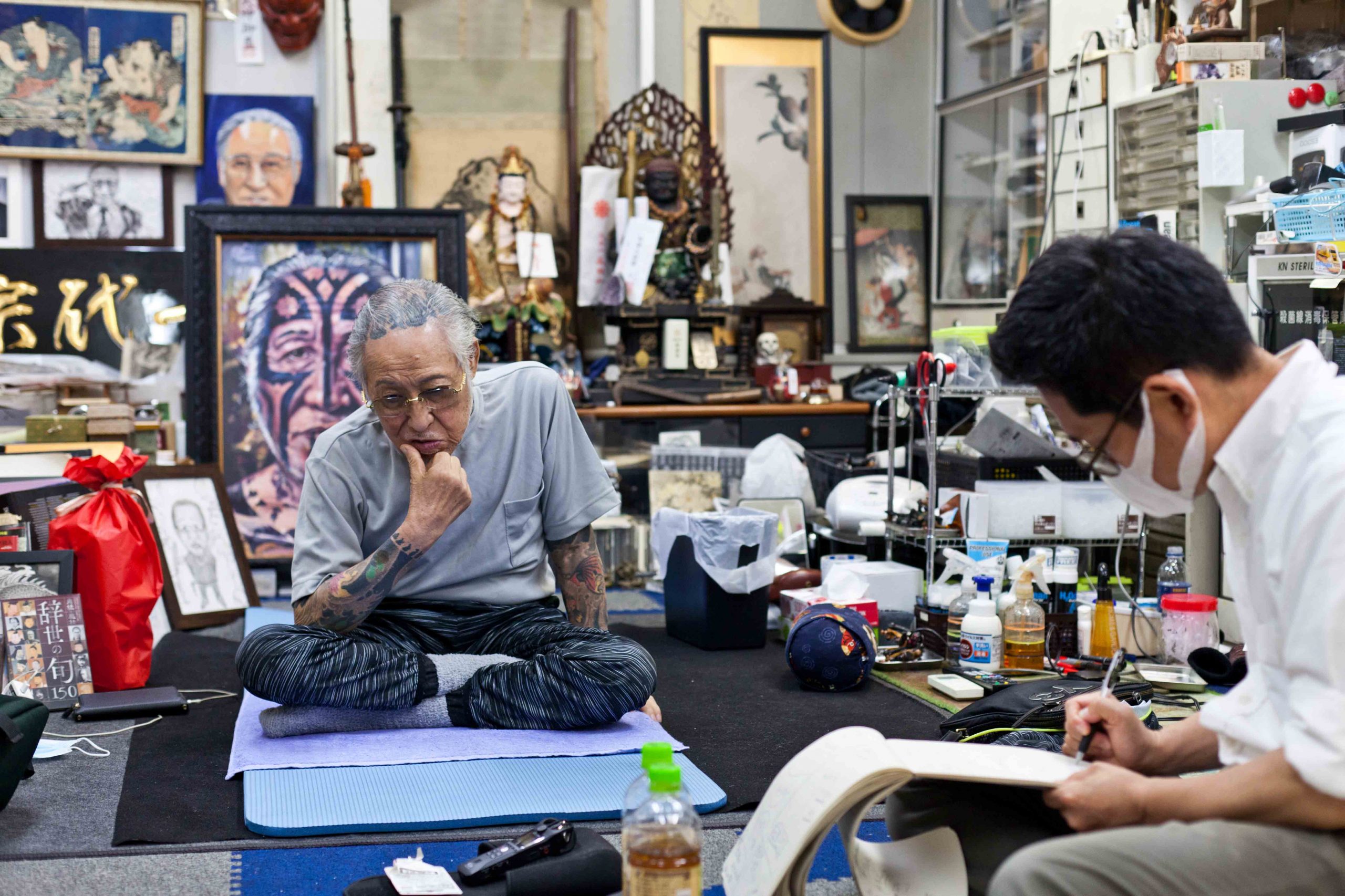
A study of Mr. Takagi’s first novel, in which tattoos are at the heart of the plot, raises questions about the veracity of certain elements used by the author to construct her story. I’m thinking in particular of the curse mentioned in the book, which results from the fatal combination of three Sansukumi motifs. Does this belief, this superstition, really exist among tattoo artists?
It exists, but it’s not really applied. Sansukumi has its origins – as do most of the designs – in a genre of books that existed in the Edo period: yomihon. It’s a kind of tale. If the frog eats the slug and the snake eats the frog, the snake dies poisoned by the slug. They can’t attack each other. At the end of the story, the slug and the frog team up against the snake, which eventually runs away.
The Horigorō family, whom I contacted during my research, claim that they were the first in the history of tattooing in Japan to use the electric tattoo machine. What do you think?
Perhaps, yes. Horigorō I frequented foreigners, which may indeed explain why he acquired it. At the time, these machines were said to make an enormous amount of noise. You could apparently hear them working even in the street when they were in action upstairs in a building. Horigorō is said to have built his own, based on models made by foreigners. However, I don’t think he was the first Japanese tattooist to use it.
Why was that?
Because there were tattooers all over Japan. For example, during the Meiji period, one of them was called Horichyo. I have several of his drawings, which are fine and precise. Some represent dragonflies, others butterflies, and it seems impossible to me to tattoo them without the help of a machine. I deduce that this tattooer had one. Horichyo frequented a foreign dealer called Arthur & Bond, so I can imagine that he got it through him. In an article about this tattooer, who died prematurely, there is mention of a machine powered by electricity, and I suppose it was probably used for tattooing. This leads me to believe that one already existed in Japan in the Meiji period. The Horigorō era comes a little later. Horichyo’s master was from Osaka, so it’s reasonable to imagine that he also used it.
Did your master, Horiyoshi I, know about the electric tattoo machine?
Yes, of course. An Australian woman, Cindy Ray, sold equipment as far away as Japan. What’s more, my master wore a tattoo of a butterfly on his arm, done with the machine. Although he was aware of its qualities, particularly its speed of execution, he never wanted to use it. He thought it was important to preserve the Japanese tradition of working by hand. When I became his apprentice – 48 years ago – the day before each of his working days I had to prepare his tools, i.e. sharpen the needles and place them precisely on the tools.
Do you think tebori tattooing is dying out in Japan, or do you feel that new generations are interested in this technique?
I think my generation will be the last to practise tebori in an authentic way. Preparing good needles and knowing how to attach them to the tool, I don’t know if there are people who know how to do that properly.
